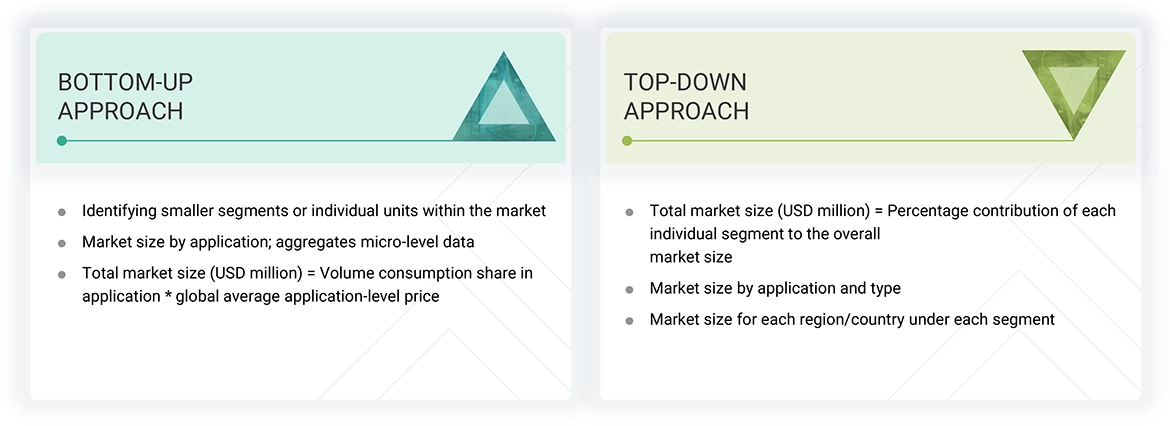The study involved four major activities in estimating the size of the emollient market. Exhaustive secondary research was done to collect information on the market, the peer market, and the parent market. The next step was to validate these findings, assumptions, and sizing with industry experts across the value chain through primary research. Both top-down and bottom-up approaches were employed to estimate the complete market size. After that, the market breakdown and data triangulation procedures were used to estimate the market size of the segments and subsegments.
Secondary Research
Secondary sources used in this study included annual reports, press releases, and investor presentations of companies; white papers; certified publications; articles from recognized authors; and gold standard & silver standard websites such as Factiva, ICIS, Bloomberg, and others. The findings of this study were verified through primary research by conducting extensive interviews with key officials such as CEOs, VPs, directors, and other executives. The breakdown of the profiles of the primary interviewees is illustrated in the figure below.
Primary Research
The emollient market comprises several stakeholders, such as raw material suppliers, end-product manufacturers, and regulatory organizations in the supply chain. The demand side of this market is characterized by key opinion leaders in various applications for the emollient market. The supply side is characterized by advancements in technology and diverse application industries. Various primary sources from both the supply and demand sides of the market were interviewed to obtain qualitative and quantitative information.
Breakdown of Primary Participants

Note: Tier 1, Tier 2, and Tier 3 companies are classified based on their market revenue in 2023/2024, available in the public domain, product portfolios, and geographical presence.
Other designations include consultants and sales, marketing, and procurement managers.
To know about the assumptions considered for the study, download the pdf brochure
|
COMPANY NAME |
DESIGNATION |
|
BASF SE |
Senior Manager |
|
Croda International plc |
Innovation Manager |
|
Evonik Industries AG |
Vice President |
|
Lubrizol Corporation |
Production Supervisor |
|
Clariant AG |
Sales Manager |
Market Size Estimation
Both top-down and bottom-up approaches were used to estimate and validate the total size of the emollient market. These methods were also used extensively to estimate the size of various subsegments in the market. The research methodology used to estimate the market size includes the following:
-
The key players in the industry have been identified through extensive secondary research.
-
The supply chain of the industry has been determined through primary and secondary research.
-
All percentage shares, splits, and breakdowns have been determined using secondary sources and verified through primary sources.
-
All possible parameters that affect the markets covered in this research study have been accounted for, viewed in extensive detail, verified through primary research, and analyzed to obtain the final quantitative and qualitative data.

Data Triangulation
After arriving at the overall market size—using the market size estimation processes as explained above—the market was split into several segments and subsegments. To complete the overall market engineering process and arrive at the exact statistics of each market segment and subsegment, data triangulation and market breakdown procedures were employed, wherever applicable. The data was triangulated by studying various factors and trends from both the demand and supply sides in the emollient industry.
Market Definition
Emollients are one of the largest categories of highly functional specialty ingredients effectively used in cosmetic and personal care formulations to impart soft, smooth, hydrated skin. Emollients work by forming an oily water-repellent layer on the skin’s surface, helping to seal up moisture close to the skin’s surface, improving the skin’s texture and appearance. Emollients are a key ingredient in numerous specialty chemicals used in thousands of skincare, hair care, and personal care products, from pharmaceuticals to consumer-produced goods, in industries ranging from beauty, fashion, and entertainment.
Stakeholders
-
Emollient Manufacturers
-
Emollient Distributors
-
Raw Material Suppliers
-
Service Providers
-
Government and Research Organizations
Report Objectives
-
To define, describe, and forecast the market size for emollients in terms of value
-
To provide detailed information about drivers, restraints, opportunities, and challenges influencing the market growth
-
To analyze and forecast the emollient market by type, form, and application
-
To forecast the market based on key regions, namely, North America, Europe, Asia Pacific, the Middle East & Africa, and South America
-
To strategically analyze the micromarkets with respect to individual growth trends, prospects, and their contribution to the overall market
-
To track and analyze recent developments, such as product launches, deals, expansions, and other developments, in the market
-
To analyze the opportunities for stakeholders in the market and provide a competitive landscape for market leaders
-
To strategically profile the key players and comprehensively analyze their market shares and core competencies



Growth opportunities and latent adjacency in Emollient Market